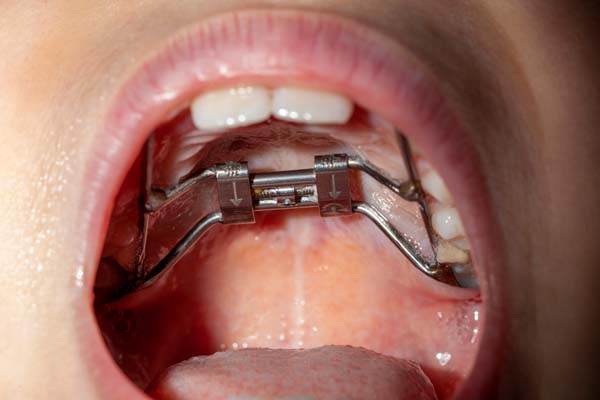When Is a Palatal Expander Necessary?

Sometimes, as they grow up, some children develop a narrow upper jaw. Having a narrow jaw can lead to dental problems down the road, such as bite problems or tooth decay. Palatal expanders may be able to help. Understanding narrow jaws can help your child receive the necessary care and improve the overall dental health they deserve. Continue reading to learn more about the conditions that may lead to a dental professional recommending a palatal expander as a treatment option.
What is a palatal expander?
A palatal expander is an orthodontic appliance that aims to widen the upper jaw by applying steady pressure on each side of the palate. This pressure pushes the two halves apart and widens the upper jaw over time. As the palate widens, new bone regenerates and fills the empty space. Depending on the severity of the narrow jaw, treatment can take anywhere between a few weeks to a year.
Orthodontists and other dental professionals often recommend them for children and adolescents whose jaws are developing. However, an adult can also get a palatal expander to widen a narrow jaw if they could not get treatment when they were a child. Expanders can be removable or fixed in place.
When a palatal expander is necessary
There are several reasons why a patient may need a palatal expander. The following includes the most common.
1. Crossbite
One of the most common reasons for a palatal expander is to treat a crossbite. A crossbite occurs when the upper teeth are located inside the lower teeth when the jaws are closed. This can cause problems with biting, chewing, and speaking. It can also lead to jaw pain and headaches. A palatal expander can help to widen the upper jaw and correct the crossbite.
2. Crowding
Crowding occurs when there is not enough space in the mouth for all of the teeth to fit properly. It can lead to crooked or misaligned teeth, which can cause problems with biting, chewing, and speaking. A palatal expander can help create more space in the mouth by widening the upper jaw, preventing crowding and allowing the teeth to come in properly.
3. Narrow arch
Some patients may have a narrow arch, which can cause problems with the alignment of the teeth and jaws. A narrow arch can also lead to breathing problems, as there may not be enough space for the tongue and airway. A palatal expander can help widen the arch, improving the alignment of the teeth and jaws and alleviating breathing problems.
4. Other bite issues
Patients may have other bite problems, such as an overbite or underbite, which can lead to teeth and jaw alignment issues. A palatal expander can help to correct bite problems by widening the upper jaw and improving the alignment of the teeth.
5. Speech problems
Issues with jaw and teeth alignment can contribute to speech problems. If the upper jaw is too narrow, it can cause problems with speech, such as a lisp or difficulty pronouncing certain words. A palatal expander can help to widen the upper jaw and improve speech.
6. Impacted teeth
Impacted teeth occur when teeth do not erupt properly and become stuck in the gums or bone. This can result from a lack of space in the mouth, which is treatable with a palatal expander. A palatal expander can create more space for teeth to erupt properly and prevent impaction by widening the upper jaw.
Call our office today
If you or your child are experiencing any of the above issues, a palatal expander may be an effective treatment option. Give our office a call today to schedule a consultation. Our team can help determine if a palatal expander is a right choice for you or your child's dental health. We can also answer any questions or concerns you may have.
Valley Ranch Orthodontics offers palatal expander treatment in the Irving area. Visit our website at https://valleyranchorthodontics.com or call our office at (972) 200-1016 to make an appointment.
Check out what others are saying about our services on Yelp: Read our Yelp reviews.
Related Posts
The first thing to do when experiencing a toothache is to assess the tooth and surrounding area. Sometimes, the reason for a toothache is obvious; other times, not so much. Depending on the cause of a toothache, seeking the help of an orthodontist may be more appropriate than a general dentist. The following article will…
Properly aligned teeth boost confidence in your smile and support good oral health. Finding an orthodontist with the skill set and experience you need is important. If you are still trying to figure out where to start, we have some advice to make your search easier. Rather than spending hours hunting for an orthodontist, you…
No matter how old a person is, almost anyone can benefit from teeth straightening. However, it is important to find an orthodontist for teeth straightening because they are ADA-recognized specialists in treatments to align the bite and straighten teeth. Working with an orthodontist to correct alignment problems with the teeth offers a host of benefits…
Invisalign® has become a popular option for teeth straightening as it offers an array of benefits that other options do not. Specifically, holistic dentists recommend Invisalign® due to the relatively natural approach that the treatment offers. Having an understanding of holistic dentistry is important, as it then allows individuals to consider specific treatment options, such as…


